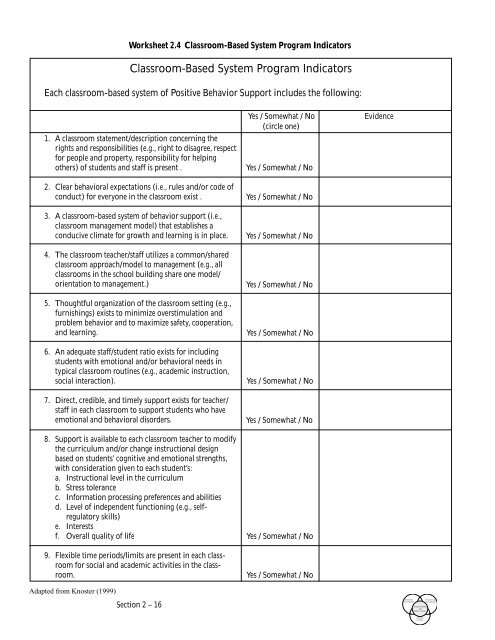Positive Behavior Support for ALL Michigan ... - Oakland Schools
Positive Behavior Support for ALL Michigan ... - Oakland Schools
Positive Behavior Support for ALL Michigan ... - Oakland Schools
You also want an ePaper? Increase the reach of your titles
YUMPU automatically turns print PDFs into web optimized ePapers that Google loves.
Worksheet 2.4 Classroom-Based System Program Indicators<br />
Classroom-Based System Program Indicators<br />
Each classroom-based system of <strong>Positive</strong> <strong>Behavior</strong> <strong>Support</strong> includes the following:<br />
1. A classroom statement/description concerning the<br />
rights and responsibilities (e.g., right to disagree, respect<br />
<strong>for</strong> people and property, responsibility <strong>for</strong> helping<br />
others) of students and staff is present .<br />
2. Clear behavioral expectations (i.e., rules and/or code of<br />
conduct) <strong>for</strong> everyone in the classroom exist .<br />
3. A classroom-based system of behavior support (i.e.,<br />
classroom management model) that establishes a<br />
conducive climate <strong>for</strong> growth and learning is in place.<br />
4. The classroom teacher/staff utilizes a common/shared<br />
classroom approach/model to management (e.g., all<br />
classrooms in the school building share one model/<br />
orientation to management.)<br />
5. Thoughtful organization of the classroom setting (e.g.,<br />
furnishings) exists to minimize overstimulation and<br />
problem behavior and to maximize safety, cooperation,<br />
and learning.<br />
6. An adequate staff/student ratio exists <strong>for</strong> including<br />
students with emotional and/or behavioral needs in<br />
typical classroom routines (e.g., academic instruction,<br />
social interaction).<br />
7. Direct, credible, and timely support exists <strong>for</strong> teacher/<br />
staff in each classroom to support students who have<br />
emotional and behavioral disorders.<br />
8. <strong>Support</strong> is available to each classroom teacher to modify<br />
the curriculum and/or change instructional design<br />
based on students’ cognitive and emotional strengths,<br />
with consideration given to each student’s:<br />
a. Instructional level in the curriculum<br />
b. Stress tolerance<br />
c. In<strong>for</strong>mation processing preferences and abilities<br />
d. Level of independent functioning (e.g., selfregulatory<br />
skills)<br />
e. Interests<br />
f. Overall quality of life<br />
9. Flexible time periods/limits are present in each classroom<br />
<strong>for</strong> social and academic activities in the classroom.<br />
Adapted from Knoster (1999)<br />
Section 2 – 16<br />
Yes / Somewhat / No<br />
(circle one)<br />
Yes / Somewhat / No<br />
Yes / Somewhat / No<br />
Yes / Somewhat / No<br />
Yes / Somewhat / No<br />
Yes / Somewhat / No<br />
Yes / Somewhat / No<br />
Yes / Somewhat / No<br />
Yes / Somewhat / No<br />
Yes / Somewhat / No<br />
Evidence
















